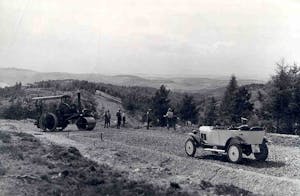The Nürburgring’s very first race weekend began on this day in 1927
Between the two world wars, the west German countryside around Nürburg was carved into what has become one of the greatest road courses ever built. The Green Hell broke ground in September of 1925 as something of a local public works project for the Eifel region. Over $30 million went to construct the initial 17.5-mile course, thanks to the braintrust of Dr. Otto Creuz, Gustav Eichler, and Konrad Adenauer. Dr. Creuz had drummed up the idea as a way to pump money into the economically depressed region, and Eichler’s architecture firm designed the paved course as a somewhat-tamed version of the Targa Florio, tailored for road racing but better insulated from ocean squalls and free from Sicily’s muddy slogs. Adenauer, mayor of nearby Cologne, helped drum up political support in order to secure funding for the track.


This project would’ve been a major undertaking even today, when we have nearly a century’s worth of specially-designed machinery to chisel and pave the hills around the Nürburg castle. In 1927, however, coal-fired brutes and hand-thrown shovels graded the countryside into a flowing course. Construction wrapped up in 1927, and the Nürburgring boasted several configurations that essentially coalesced into the two-track configuration seen today.
June 18, 1927, marked the first race on the new course. Saturday’s schedule for the “Eifelrennen,” or Eifel Race, began with motorcycle races. Barely evolved from their motorized-bicycle roots, these two-wheeled terrors battled until Toni Ulmen with his 350-cc Velocette came out on top. On the following day, Mercedes-Benz began to establish its dominance with a 1-2-3 finish led by Rudolf Caracciola with a supercharged Model S.
Following the Eifel Race, the Nürburgring opened its lanes to the public as a one-way toll road. For a few bucks, you could run the course on evenings or weekends. Thanks both to amateur and professional drivers, the Nürburgring’s legacy was thus cemented as one of the most rewarding and challenging courses in automotive history.

